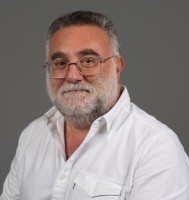CIRC Partner Prof. Michele Migliore

Prof. Michele Migliore |
|
 |
Team Name: ‘Computational Neuroscience Laboratory’
Link to team page: http://www.pa.ibf.cnr.it/personale/migliore/index.html
Institute: Institute of Biophysics, National Research Council (CNR-IBF)
Address: via Ugo La Malfa 153, 90143 Palermo (Italy)
Description of research
 |
Over the past 30 years the Computational Neuroscience Laboratory of CNR-IBF, headed by Michele Migliore, has been involved in the development and implementation of computational models of complex systems. The broad long-term goal is to investigate, using realistic models and state of the art simulations techniques, the basic processes underlying the nervous system functions and dysfunctions. In close interdisciplinary collaboration with leading experimental laboratories, we investigate neuronal networks and single neurons at different integration levels, always closely related to the available experimental data. The primary current research interests are the mechanisms of learning and memory, synaptic integration, and ion channels function, in the attempt to link behavioral and dysfunctional processes with signal processing at the single neuron or network level. |
Research to be done in the context of Circprot
| We will use computational simulation of neuronal output in realistic models of microcircuits to better understand the pathological outcome of altered BDNF-dependent synaptic plasticity. Morphologically/biophysically realistic models of hippocampal CA1 pyramidal neurons and Striatum Medium Spiny Neurons will be implemented and validated against experimental data on the effects of drug addiction. Synaptic inputs will be implemented, distributed, activated, and dynamically modified using spike-time-dependent plasticity (STDP) rules derived from experimental data obtained under control and Alzheimer’s Disease (HD) or Huntington Disease (HD) conditions. The main aim is to predict which BDNF-dependent synaptic plasticity mechanisms, in hippocampus and striatum, are involved in the alteration of signal integration/propagation observed in AD and HD mice. These predictions will be tested by electrophysiology in the diseased neurons. To investigate effects at the circuit level in the hippocampus, we will use an improved version of our previously developed CA1 network model. We will study how BDNF-dependent changes affect experimentally testable properties of single neurons and predict the expected changes in network properties such as spike synchronization and storage/recall. |  |


Key publications
V Breton-Provencher, K Bakhshetyan, D Hardy, R Bammann, F Cavarretta, M Snapyan, D Coté, M Migliore, and A Saghatelyan (2016) Principal cell activity induces spine relocation of adult-born interneurons in the olfactory bulb, Nature Comm, 7:12659. doi: 10.1038/ncomms12659.
Migliore M, Cavarretta F, Marasco A, Tulumello E, Hines ML, Shepherd GM. (2015) Synaptic clusters function as odor operators in the olfactory bulb, Proc Natl Acad Sci U S A. 112(27):8499-504.
Miceli F, Soldovieri MV, Ambrosino P, De Maria M, Migliore M, Migliore R, Taglialatela M. (2015) Early-Onset Epileptic Encephalopathy Caused by Gain-of-Function Mutations in the Voltage Sensor of Kv7.2 and Kv7.3 Potassium Channel Subunits, J. Neurosci. 35(9):3782-93.
Bianchi D, De Michele PD, Marchetti C, Tirozzi B, Cuomo S, Marie H, Migliore M (2014), Effects of increasing CREB-dependent transcription on the storage and recall processes in a hippocampal CA1 microcircuit, Hippocampus. 24:165-77.
F Miceli, MV Soldovieri, P Ambrosino, M Migliore, MR Cilio, and M Taglialatela, (2013) Genotype-phenotype correlations in neonatal epilepsies caused by mutations in the voltage sensor of Kv7.2 potassium channel subunits, Proc. Nat. Acad. Sci. USA, 110:4386-91.






